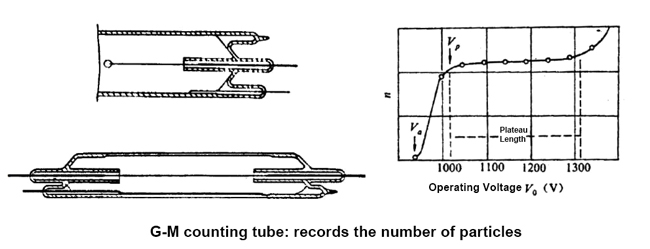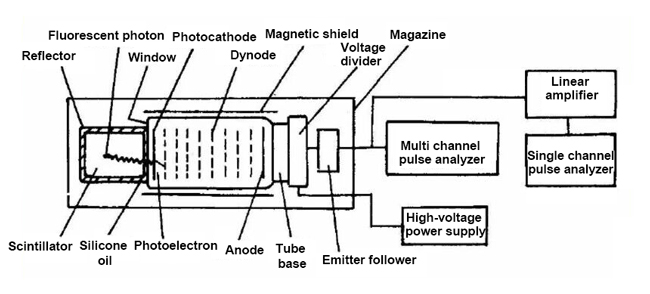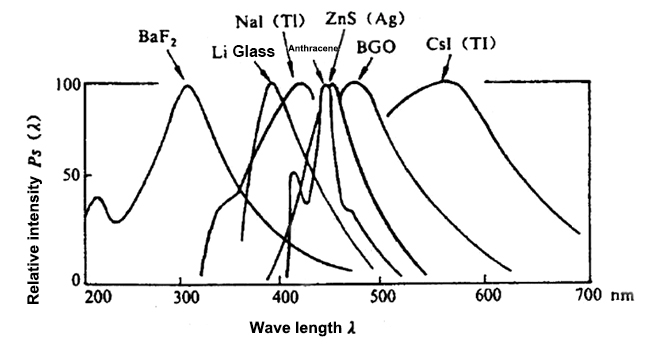What is the Nuclear Radiation Detector Type?
Nuclear radiation detectors play a crucial role in safeguarding our world by monitoring and measuring ionizing radiation. Whether it's for ensuring the safety of nuclear power plants, protecting workers in radiation-prone environments, or even detecting radiation in the aftermath of a nuclear accident, these detectors are essential tools. In this blog post, we will explore the various types of nuclear radiation detectors.
Radiation detectors can be primarily classified into two categories based on how they provide information:
The first category involves particle detectors that require specific processing steps to generate information perceivable by humans. For example, various particle trajectory detectors often undergo processes such as photography, imaging, or chemical etching, and in some cases, radiation monitoring instrumentations. Thermal luminescence detectors and photoluminescence detectors fall into this category, as they require thermal or optical excitation to produce light output related to the incident radiation. These detectors generally do not fall within the scope of nuclear electronics research.
The second category includes detectors that immediately produce corresponding electrical signals upon receiving incident particles. These detectors are termed as "electric detectors." Electric detectors are the most widely used radiation detectors. They generate electrical signals that can be amplified and processed through electronic circuits for recording and analysis. The development of electric detectors gave rise to the emergence and growth of nuclear electronics as a new branch of science.
There are over a hundred types of nuclear radiation detectors that can produce electrical signals. The most commonly used ones fall into three major categories: gas ionization detectors, semiconductor detectors, and scintillation detectors. Gas ionization detectors have been available since as early as 1908, but it wasn't until 1931 when pulse counters were introduced that the issue of fast counting was resolved. In 1947, the introduction of scintillation counters significantly improved the detection efficiency due to their higher density compared to gases. Notably, thallium-doped sodium iodide scintillators have good energy resolution capabilities for gamma rays. In the early 1960s, the successful development of semiconductor detectors brought about new advancements in energy spectrum measurement techniques. Modern detectors and devices used in various fields, including high-energy physics, nuclear physics, and other scientific and technological domains, have evolved through continuous innovation and improvement of these three types of detectors.
Counters
Counters record and analyze information related to radiation in the form of electrical pulses. Types of counters include gas ionization detectors, multi-wire chambers and drift chambers, semiconductor detectors, scintillation counters, and Cherenkov counters.
Gas Ionization Detectors
Gas ionization detectors measure nuclear radiation by collecting the ionization charges produced by radiation in a gas medium. The main types include ionization chambers, proportional counters, and Geiger-Muller (G-M) counters. They share a similar structure, typically consisting of a cylindrical container with two electrodes and a gas fill. The key difference lies in the range of operating voltages. Ionization chambers operate at lower voltages and directly collect the ion pairs generated by radiation in the gas. They produce pulses with small amplitudes and fast rise times, suitable for radiation dose measurements and energy spectrum measurements. Proportional counters operate at higher voltages, leading to the production of more ion pairs by the fast-moving original ions in the electric field (gas amplification), resulting in higher pulse output. The pulse amplitude is proportional to the energy loss of the incident particles, making them suitable for energy spectrum measurements. Geiger counters, also known as Geiger-Muller counters or G-M counters, operate at even higher voltages and undergo multiple ionization processes. As a result, their output pulses have very high amplitudes and are no longer proportional to the number of original ion pairs. They can be recorded without the need for amplification but can only measure the number of particles, not their energy. The time required for a single pulse count is relatively long.

Multi-Wire Chambers and Drift Chambers
These are variations of proportional counters that combine counting capabilities with the ability to discriminate the regions through which charged particles pass. Multi-wire chambers consist of numerous parallel wire electrodes in the same operating state as proportional counters. Each wire and its adjacent space act as a separate detector, connected to a recording instrument. Thus, an event is only recorded when the detected particle enters the space near the wire, and the corresponding recording instrument is triggered. To reduce the number of wire electrodes, drift chambers use the time taken for ions to drift to the wire as a means to determine the position of ion generation. Another detector provides an initial signal and roughly specifies the location of the event. A counting device based on this principle is called a drift chamber, offering superior position resolution (up to 50 micrometers) but with a lower allowed counting rate compared to multi-wire chambers.
Semiconductor Detectors
Semiconductor detectors measure nuclear radiation by collecting the charge carriers (electrons and holes) generated by radiation in a semiconductor material under a reverse-biased electric field. Common semiconductor materials include silicon and germanium, and there are three main types:
- Surface-barrier detectors with a gold film on an n-type single crystal.
- Diffused junction detectors with an impurity-doped diffusion layer in high-resistivity p-type silicon.
- Lithium-drifted detectors made by depositing a thin layer of lithium metal on the surface of p-type germanium (or silicon) and allowing lithium drift. High-purity germanium detectors offer excellent energy resolution, high efficiency in detecting gamma radiation, can be stored at room temperature, and have wide-ranging applications. Other materials such as gallium arsenide, cadmium telluride, and mercury iodide are also used.
High purity germanium semiconductor detector
![]()
Scintillation Counters
Scintillation counters measure nuclear radiation by having charged particles strike a scintillating material, causing ionization and excitation of atoms (or molecules), resulting in light emission during de-excitation. Photodetectors like photomultiplier tubes are used to convert the light signal into measurable electrical signals for radiation detection. Scintillation counters offer short response times, high efficiency, and the ability to determine particle energy based on the size of the electrical signal. Scintillators can be categorized into three main types:
- Inorganic Scintillators: Common examples include thallium-activated sodium iodide (NaI(Tl)) and thallium-activated cesium iodide (CsI(Tl)) crystals, which are sensitive to electrons and gamma radiation, exhibit high light yield, and provide good energy resolution. Bismuth germanate (BGO) crystals have high density and light yield, making them effective for detecting high-energy electrons and gamma radiation. Other examples include zinc sulfide (ZnS) activated with silver (Ag), primarily used for alpha particle detection, and glass scintillators capable of measuring alpha particles and low-energy X-rays, with the ability to detect neutrons when a suitable carrier is added. Barium fluoride (BaF2) scintillators offer both energy and time measurement capabilities.
- Organic Scintillators: This category includes plastics, liquids, and crystals (such as anthracene and stilbene). The first two are more commonly used. Their short light decay times (2-3 nanoseconds, with fast plastic scintillators going below 1 nanosecond) make them suitable for time measurements. They have nearly 100% efficiency for detecting charged particles.
- Gas Scintillators: This category includes inert gases like xenon and helium. While their light yield is not very high, they exhibit short light decay times (less than 10 nanoseconds).
Scintillation counters working principle:

Scintillator:

Cherenkov Counters
Cherenkov counters measure the speed of charged particles by detecting Cherenkov radiation produced when fast-moving charged particles in a transparent medium exceed the speed of light in that medium. The emitted Cherenkov radiation angle is dependent on the particle's velocity, providing a means to measure particle speed. These detectors are often used in conjunction with photomultiplier tubes and come in two main types: threshold (which records particles with velocities above a certain threshold) and differential (which selects particles with a specific, known velocity).
In addition to the commonly used detectors mentioned above, there are also recent developments in gas detectors like gas proportional scintillation chambers and self-quenching flow counters, which offer large pulse amplitudes and excellent time characteristics. Electromagnetic calorimeters and hadron calorimeters can respectively measure the energy of high-energy electrons, gamma radiation, or hadrons (fundamental particles). Transmittance detectors provide a means for the discrimination of extremely high-energy charged particles.
Track Chambers
Track chambers measure nuclear radiation by recording and analyzing the track patterns generated by radiation. The main types include nuclear emulsions, cloud chambers, bubble chambers, spark chambers, and streamer chambers, as well as solid-state track detectors.
Nuclear Emulsions
These are photographic emulsions capable of recording the individual tracks of charged particles. The incident particles create latent image centers in the emulsion, which are then recorded through chemical processing and can be observed under a microscope. They offer exceptional position resolution (down to 1 micron), high stopping power, and continuous sensitivity.
Cloud Chambers and Bubble Chambers
These devices allow ionization clusters formed by incident particles to condense into liquid droplets (in the case of cloud chambers) or vaporize into gas bubbles (in bubble chambers) within a supersaturated vapor. The tracks of charged particles become visible and are recorded through photographic means. Bubble chambers have good position resolution (some can achieve 10 micrometers) and serve as both detectors and targets, often used in conjunction with particle counters.
Spark Chambers and Streamer Chambers
These devices require high voltages. When particles enter the chamber and undergo ionization, they experience rapid gas amplification, resulting in spark formation or streamer development, making the tracks of charged particles visible. Streamer chambers exhibit good time characteristics. They offer excellent spatial resolution (approximately 200 micrometers) and can also record electrical pulse signals for counting.
Solid-State Track Detectors
Heavy charged particles striking materials like mica, plastics, or other similar substances cause damage along their paths. After chemical treatment (etching), this damage is enlarged into visible etch pits that can be observed under a microscope. These detectors are suitable for detecting heavy nuclei.
Modern radiation spectrometers are composed of various types of detectors, magnets, electronic instruments, computers, and more, allowing for the acquisition of multiple physical parameters, marking the development trend in contemporary nuclear physics and particle detection.
Nuclear radiation detectors are indispensable test tools in our efforts to ensure safety, monitor radiation levels, and advance scientific knowledge. Each type of detector has its unique characteristics and applications, making them suitable for various settings and purposes. By understanding the different types of nuclear radiation detectors, we can better appreciate their essential role in protecting our world from the potential dangers of ionizing radiation. Whether it's in the field of healthcare, nuclear energy, or research, these detectors are vital instruments that contribute to a safer and more secure world.

